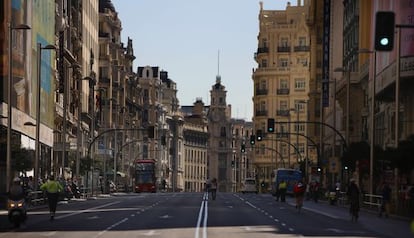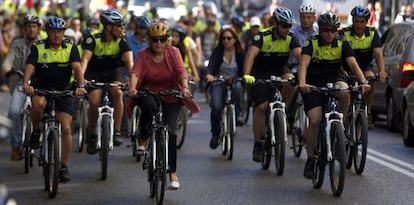Madrid City Hall to start banning cars to combat pollution
Amount of traffic on capital’s streets could soon be slashed in half on certain days

The roar of engines and honking of car horns on Madrid’s Gran Vía came to a halt for four hours on Tuesday as the busy thoroughfare was blocked off to traffic to mark European Mobility Week.
But in just a few weeks – as early as October, or by December at the latest – half of the cars currently circulating in the city could disappear from its streets for certain periods as Mayor Manuela Carmena’s new leftist municipal government activates a shock plan to tackle pollution, which will include tougher-than-ever traffic measures.
On the second day after a warning, half of all private vehicles would be banned from the city center
The plan, which should already have been put in place by previous mayor Ana Botella of the center-right Popular Party (PP), entails imposing traffic restrictions when pollution levels in the city surpass the legal limit that the European Union set in 2010.
It establishes three separate levels: a pre-warning, warning and alert. The first will be activated when two pollution measuring stations in the city center register levels of nitrogen dioxide – emitted by diesel vehicles, and the only pollutant for which Madrid exceeds EU levels – in excess of 180 micrograms per cubic meter for two consecutive hours.
On the first day this will mean limiting the speed of vehicles traveling on the M-30 beltway and the main highways running into Madrid to 70km/h.

If pollution levels have not dropped by the second day, all cars not belonging to local residents will be banned from parking in meter-regulated areas.
In the event of a warning announcement, which would occur if nitrogen dioxide levels surpassed 200 micrograms per cubic meter for two consecutive hours, these two measures would be introduced immediately.
On the second day after a warning, half of all private vehicles – according to whether they have odd or even license plates – and empty taxis will be banned from circulating in the city center.
In the event of an alert announcement, this latter measure would also be extended to the M-30.
The level for an alert set by the European Union is very high – 400 micrograms of nitrogen dioxide per cubic meter for three consecutive hours – and has so far never been reached in Madrid. But the first two warning levels, which are set by City Hall and represent a lowering of the limits set by Botella in March of this year, have been surpassed on numerous occasions.
In order to avoid traffic holdups, City Hall has said it plans to increase public transport services and make them free on affected days, though such a move would require the blessing of the PP-run regional government.
English version by Nick Funnell.
Tu suscripción se está usando en otro dispositivo
¿Quieres añadir otro usuario a tu suscripción?
Si continúas leyendo en este dispositivo, no se podrá leer en el otro.
FlechaTu suscripción se está usando en otro dispositivo y solo puedes acceder a EL PAÍS desde un dispositivo a la vez.
Si quieres compartir tu cuenta, cambia tu suscripción a la modalidad Premium, así podrás añadir otro usuario. Cada uno accederá con su propia cuenta de email, lo que os permitirá personalizar vuestra experiencia en EL PAÍS.
¿Tienes una suscripción de empresa? Accede aquí para contratar más cuentas.
En el caso de no saber quién está usando tu cuenta, te recomendamos cambiar tu contraseña aquí.
Si decides continuar compartiendo tu cuenta, este mensaje se mostrará en tu dispositivo y en el de la otra persona que está usando tu cuenta de forma indefinida, afectando a tu experiencia de lectura. Puedes consultar aquí los términos y condiciones de la suscripción digital.
Últimas noticias
The complicated life of Francesca Albanese: A rising figure in Italy but barred from every bank by Trump’s sanctions
How Japan is trying to avert ‘digital defeat’
Reinhard Genzel, Nobel laureate in physics: ‘One-minute videos will never give you the truth’
Pinochet’s victims grapple with José Antonio Kast’s rise in Chile
Most viewed
- Pablo Escobar’s hippos: A serious environmental problem, 40 years on
- Why we lost the habit of sleeping in two segments and how that changed our sense of time
- Trump’s obsession with putting his name on everything is unprecedented in the United States
- The Florida Keys tourist paradise is besieged by immigration agents: ‘We’ve never seen anything like this’
- Charles Dubouloz, mountaineering star, retires at 36 with a farewell tour inspired by Walter Bonatti








































